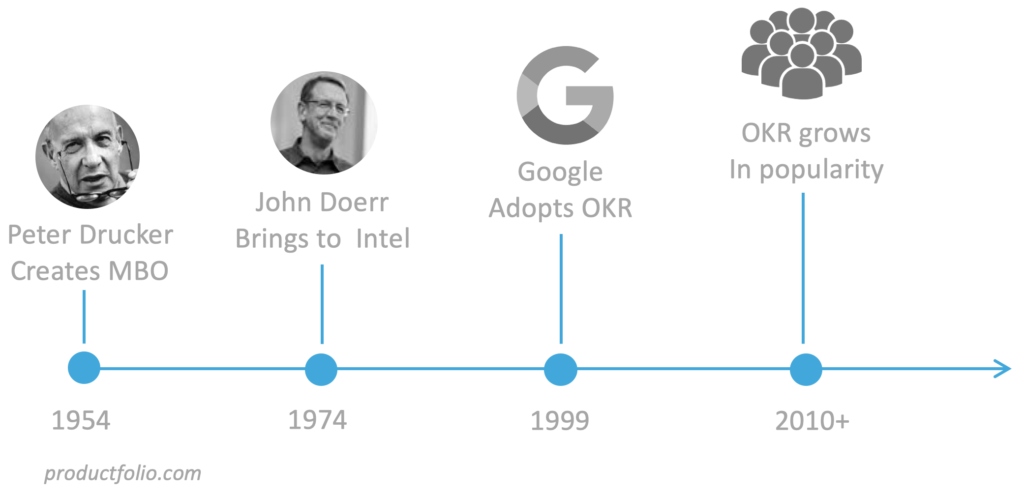OKR’s are an example of outcome-oriented management. The OKR system suggests that leaders task their team with an objective, allowing the team to determine their approach by defining the key results, to achieve the objective. This approach provides the team with empowerment and a sense of ownership, inspiring them to achieve and often surpass the objective. It also facilitates the idea of pushing decisions closer to the customer, which is essential for Product to define a strategy.
History of OKR
The OKR goal-setting system became well known in business and tech circles with the introduction from John Doerr. While working under the management of Andy Grove, Doerr became inspired to share with the world the OKR system that Andy Grove developed called “Objectives and Key Results”, later shortened to OKR’s. Grove instilled into Doerr his fundamental truth that “it almost doesn’t matter what you know, execution is what matters the most.” Grove liked to keep things simple and declared that once you’ve set your objective, you must be able to answer whether you achieved your goal with a simple yes or no. While Grove invented the OKR goal-setting system, John Doerr has created an approach that allows leaders to raise their performance and lead their team more effectively.

OKR Goal Setting
OKR stands for Objectives and Key Results. The objectives are What you want to be accomplished and the Key Results are How you’ll achieve that objective (projects, initiatives, etc). Progress toward the objective is often measured by a KPI and the impact of those key results would be measured against the KPIs, to determine their effectiveness toward the objective. For example, let’s say we’re developing a product that requires the customer to complete a purchase and so our objective will be to increase order completion. The Key Results might be that we’re going to redesign the checkout flow to reduce friction and introduce prompts to complete checkout. Our KPI would be the conversion rate (sales/session) and how we’ll measure the achievement of our objective.
OKR’s and Stretch Goals
Stretch goals are all about taking ordinary work to extraordinary levels, and in this instance using OKR’s to do so. Stretch goals are often used in an organization to keep a team inspired to reach new levels. Stagnation is a creativity killer, and implementing stretch goals helps to stimulate your team to reach their peak performance. If you do OKR’s quarterly, consider injecting a stretch goal in the objectives once annually. Doing stretch goals too often may stretch a team too far and cause them to snap, so it’s important to create stretch goals in intervals and to monitor the teams’ elasticity.
OKR’s and Lean Strategy
Creating OKR’s with your team is all about reaching a goal in a measurable actionable way. A Lean strategy is all about reaching a goal with efficiency and minimal to zero waste in time and resources. By implementing the Lean Strategy into the process of your OKR’s you’re team is more likely to achieve their measurable goals due to the reduction of waste, time and resources. A Lean strategy is a complement to the creation of an OKR.
OKR’s and SMART Goals
SMART goals work in harmony with OKR’s due to their similarities. OKR’s are very simplistic by design. You can expand on your teams OKR to create SMART OKR’s by introducing the SMART acronym:
- Make sure your Objective is Specific
- Your Key Results must be Measurable
- The OKR must be Attainable
- Make sure your OKR is Relevant
- Create a definitive Timeline
Using KPI’s with OKR’s
With OKR’s, your Objective is what you want to accomplish (your goal), your Key Results are how you get there, often measured by KPI’s (Key Performance Indicators) along the roadmap to your success. As an example, you may have an OKR that has a life cycle of one year, using KPI’s quarterly to measure your success as you reach towards your goal will help your team to make adjustments as needed to help ensure the success of your product.
Conclusion
Setting objectives for your OKR is all about being idealistic and not realistic. Create your ideal objective with your team and then scale it back until it’s stretched just past your team’s comfort zone. You want your objective to capture your team’s imagination in a way that compels them to achieve it. You also want your objective to be something that matters with respect to your organization and the product so that the team collectively aligns with the OKR. If the team is collectively aligned, inspired and the objective is action-oriented you and your team will be on your way to measurable and verifiable success.


